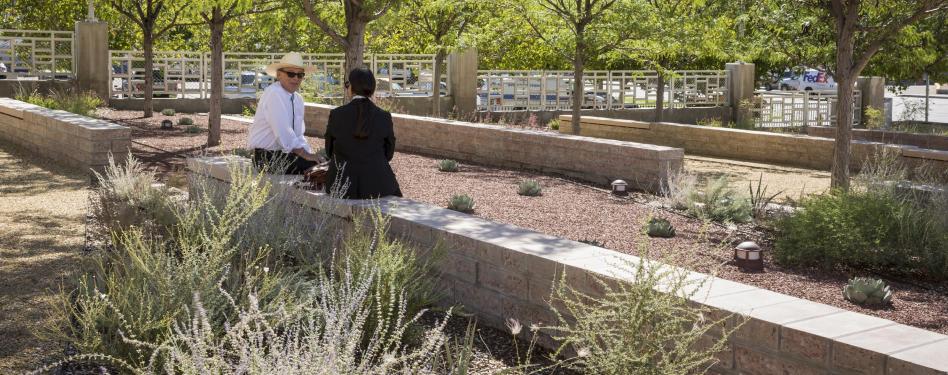
Feature image: The Pete V. Domenici U.S. Courthouse Sustainable Landscape Renovation. Photo credit: Robert Reck Photography, LLC.
Brandon Hartz, SITES AP, LEED AP, ASLA, PLA, is the senior landscape architect at the U.S. General Services Administration (GSA) and leads their landscape development strategy and implementation across the country.
As an agency of the U.S. government, GSA was founded to help manage and support federal property and provide contracting options, and now oversees 8,500 owned and leased spaces covering 150,000 acres nationwide, including office space for 1.1 million government employees. With a built-to-own model, in which GSA plans to operate and maintain facilities for their entire life cycle, prioritizing long-term efficiency led to the early adoption of sustainability strategies. GSA began requiring the SITES rating system at the Silver level for its capital construction program in 2016 and currently operates several SITES-certified locations.
“When I took on the role of senior landscape architect at the GSA almost two years ago, one of my goals was to build capacity for sustainable landscape development within the agency. I earned my SITES AP credential because I wanted to highlight a path that others at the GSA could also choose to walk,” Hartz explains. “Earning the credential wasn’t a ‘decision’ when I arrived, per se; it was a given.”
The SITES AP credential
Administered by GBCI, the SITES Accredited Professional (SITES AP) credential establishes a common framework to define an individual's knowledge in creating sustainable and resilient landscapes and other outdoor spaces. SITES APs demonstrate the skills necessary to support the SITES certification process, including participating in the design and development process, supporting and encouraging an integrative design process, managing the application and certification process, and providing advocacy and education for the adoption of SITES.
“Being credentialed helps identify me as a subject matter expert from the get-go. It indicates you can be a leadership voice in those early discussions about a project site's future,” notes Hartz. “It shows elevated competency for solving problems through ecosystem services: identifying opportunities, coordinating change and implementing high impact strategies through certification.”
GSA’s SITES certifications are an ongoing group effort, Hartz is quick to point out. “I do what I can to steer our organization in the right direction. The real artistry is due to the talent of the landscape architects I am fortunate to work with on projects. It’s a team effort to create a biodiverse and resilient landscape.”
Prioritizing sustainability in landscape design and development
“This is about stepping back and looking around us. Our world has indeed changed from when I first started practicing landscape architecture. There is ample evidence that we’ve entered a new era of environmental threats: extreme weather, more wildfires and droughts, dangerously extreme heat,” Hartz says, noting that we hit records for the hottest day and year on record in 2023. “My worry is that our existing infrastructure can’t keep up with the changing climate. When we try to imagine four to six decades into the future, we can’t predict it, though the places we are currently designing will likely still be in use. We have to build resilience into these projects to account for that future use, too.”
Hartz believes that we can’t uncouple biodiversity and climate change. “Habitat fragmentation and biodiversity loss are huge threats that we must constantly work against. With climate change reaching all corners of the earth, that includes corners that we currently think we’ve protected. All the work we do should be helping each other actively invest in spaces that combat the climate crisis.”
For Hartz, weaving sustainability into his landscape architecture practice is a moral obligation.
“Earning the SITES AP credential was a reflection not only of my professional competency, but of my values,” Hartz noted. “I work toward the preservation of landscapes and a sustainable future for my profession and for my family.”
